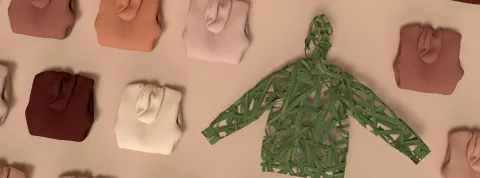
Understanding Slow Fashion: Toward Ethical and Sustainable Style
In a world where fashion seems to accelerate endlessly collection after collection the concept of slow fashion is steadily gaining ground. Slow fashion emphasizes both sustainability and ethics, with the goal of creating a better world for both people and the planet. Pause for a moment, slow down, and take the time to understand why slow fashion is much more than just a trend.
What is Slow Fashion?
Origins and principles of the movement
Emerging in the early 2000s, slow fashion was directly inspired by the slow food movement, which originated in Italy as a response to fast food and aimed to bring meaning back to what we eat. Slow fashion follows the same principle but for our wardrobes.
In practice, it’s about producing and consuming differently. Less, but better. This means smaller collections, higher-quality garments, longer production cycles, and carefully selected raw materials. The idea? Move away from a “throwaway culture” and return to a fashion that lasts, while respecting people and the planet.
Brands that follow the slow fashion model are committed to creating clothing that is durable and designed to stand the test of time without losing style. These are well-designed, well-made, and fairly paid garments and that changes everything.
A Response to the Excesses of Fast Fashion
Why slow down? Because fashion has taken a worrying turn. First with brands like H&M and Zara, and more recently with ultra-fast fashion giants like Shein, Primark, or Temu. With the rise of fast fashion came an explosion in collections, accelerated production cycles, and slashed prices. The result: rampant overconsumption, massive ecological impact, and often disastrous working conditions in producing countries.
In response to these issues, more and more consumers and designers have decided to say stop. Slow fashion is their answer: a different approach to fashion that values mindful consumption over impulsive buying, and quality over quantity.
That doesn’t mean sacrificing style or creativity quite the opposite. Ethical fashion is redefining the codes of luxury by reviving strong values: authenticity, respect, transparency. It’s also what we increasingly refer to as eco-responsible fashion.
The Pillars of Responsible Fashion
Ethical production and working conditions
Wearing a garment also means wearing its story. And too often, that story involves social injustice. In the fast fashion world, production chains are long, opaque, and human rights are often an afterthought.
Responsible fashion, by contrast, starts with a strong ethical foundation. It means ensuring fair working conditions, decent wages, and transparent practices throughout the supply chain. Committed brands choose to work with certified workshops often smaller operations where people are not just cogs in a machine but true contributors to the creative process.
This is also a virtuous circle: producing better means valuing craftsmanship and giving meaning to every piece.
Sustainable materials: organic cotton, linen, recycled fabrics
Another pillar of slow fashion is material selection. The focus is on sustainable fabrics chosen for their reduced environmental impact. This includes organic cotton, grown without pesticides and using less water; linen, a low-impact local fiber; and recycled textiles, which are becoming increasingly common in collections.
But it’s not just about raw materials. It’s also about becoming more aware of what lies behind a garment its life cycle, its transformation, its recyclability. In short, it’s an invitation to consume more consciously.
Fewer collections, more transparency
Eco-responsible fashion also means slowing down the pace no more 52 micro-collections a year. Committed brands prioritize long-term quality over constant novelty. They rethink their production calendars, offer timeless, durable pieces, and share the behind-the-scenes of their manufacturing processes.
Transparency has become a true expectation for today’s consumers. How is this T-shirt made? Who sewed it? Where was it dyed? Slow fashion brands that embrace openness earn trust and loyalty.
The Bachelor Luxe program at Sup de Luxe teaches the fundamentals of marketing, communication, and management, with a specialization in the high standards of the luxury sector. Students learn to combine innovation, creativity, and responsibility key assets to shape a more sustainable and desirable future for fashion.
How to Embrace Slow Fashion in Everyday Life
Buy less, but better
Perhaps the most obvious and most powerful advice: reduce the number of garments purchased and focus on quality pieces. Say goodbye to impulse buys driven by a discount or a flashy campaign. Instead, take time to ask yourself whether you truly need this item, and whether you’ll wear it often and for years to come.
Better to invest in a beautifully tailored shirt that will last for years than in five fast-fashion tops destined for the back of the closet. It’s a simple way to encourage responsible consumption while affirming a more personal and intentional style.
Second-hand and repair culture
Another great habit: give clothing a second life. Second-hand fashion is booming and that’s great news. Thrift stores, online platforms, clothing swaps among friends... There are countless stylish and responsible alternatives to buying new.
And when a piece gets damaged? Repair it, transform it, sew it back together. A missing button or a loose seam shouldn’t mean throwing the item away. Giving new life to your clothes is also a way of restoring their value.
Learn to read labels and certifications
To make informed choices, you need to know what to look for. More and more brands claim ecological commitments but not all are created equal. To avoid greenwashing, it’s important to know the main certifications: GOTS (for organic textiles), Fair Wear Foundation (for working conditions), OEKO-TEX (for non-toxic substances), etc.
These labels help identify truly ethical and sustainable clothing. And that’s the whole point of ethical fashion: making the invisible visible and allowing everyone to consume with full awareness.
Slow fashion represents a radical shift toward a more sustainable, ethical, and mindful approach to fashion consumption. By choosing quality over quantity, supporting ethical brands, and making informed decisions, we can contribute to a healthier planet and a more just society. Are you ready to join the movement?
